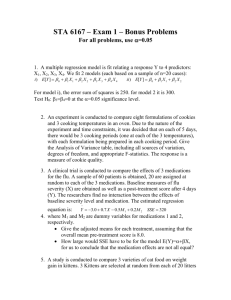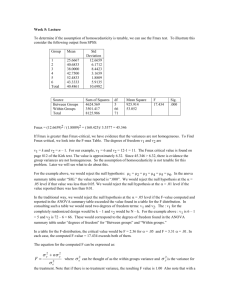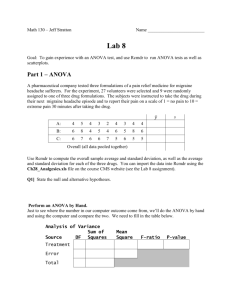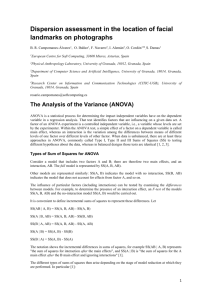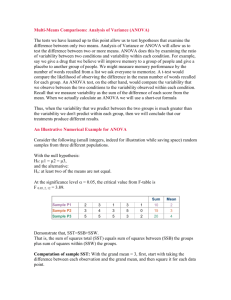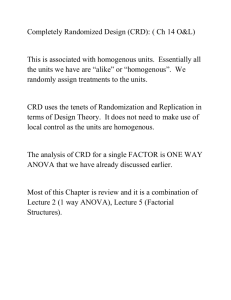ppt
advertisement
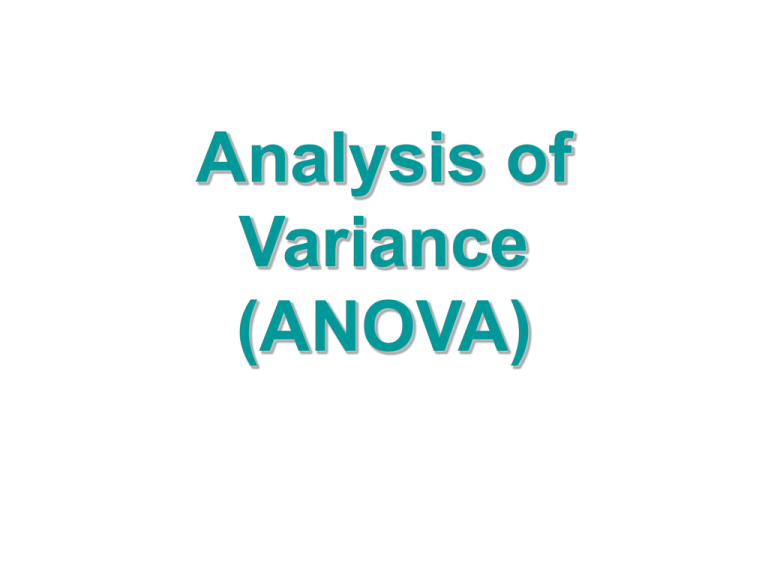
Analysis of Variance (ANOVA) When ANOVA is used.. • All the explanatory variables are categorical (factors) • Each factor has two or more levels • Example: You have 60 DNA samples from 3 plants: A, B, and C. And you measured DNA concentration once for each sample. Explanatory variable will be plants. One-way ANOVA • A single factor with three or more levels. • Example: see previous example Multi-way ANOVA • Two or more factors. • Example: You measured concentration of DNA samples from 3 plants (A, B, and C) that were grown in four different soils (K, M, N, P) - two-way ANOVA Multi-way ANOVA • Null hypotheses: The results of a twoway anova include tests of two null hypotheses: that the means of observations grouped by one factor are the same; that the means of observations grouped by the other factor are the same; • Model=concentration~plant+soils Factorial ANOVA • When there is replication at each combination of levels in a multi-way ANOVA. • Example: You measured 3 times concentration of DNA samples from 3 plants (A, B, and C) that were grown in four different soils (K, M, N, P) - two-way ANOVA with replication Factorial ANOVA (cont.) • Null hypotheses: The results of a two-way anova with replication include tests of three null hypotheses: that the means of observations grouped by one factor are the same; that the means of observations grouped by the other factor are the same; and that there is no interaction between the two factors. The interaction test tells you whether the effects of one factor depend on the other factor. • Model=concentration~plant+soils+plant:soils ANOVA ANOVA compares the mean values by comparing variances. It calculates the total variation (SSY) and partitioning it into two components: explained variation (SSA) and unexplained variation (SSE) SSA SSY SSE Total variation • SSY- the total sum of squares is the sum of squares of the differences between the data points and the overall mean, n is number of samples per treatment, k is the number of treatments k SSY n i 1 j 1 ( y ij y ) 2 Unexplained variation • SSE- error sum of squares is the sum of the squares of the differences between the data points and their individual treatments mean k SSE n i 1 j 1 ( y ij y j ) 2 Explained variation • SSA- treatment sum of squares is the sum of the squares of the differences between the individual treatment means and the overall mean k SSA n ( y i y ) 2 i 1 • The amount of the variation explained by differences between the treatment means Explained variation (cont.) • SSA=SSY-SSE • The larger difference between total variation and unexplained variation (SSYSSE) the larger explained variation (SSA) • the greater the deference between treatment means Before starting ANOVA 1. Check for constancy of variance Is the variances differ by more than factor of 2? 2. Test homogeneity of variance Is Fligner-Killeen test showing significant pvalue? Analysis of sample Assumptions • • • • Independence of samples elements Normality Homogeneity Sufficient sample sizes, equal sample sizes is the best

